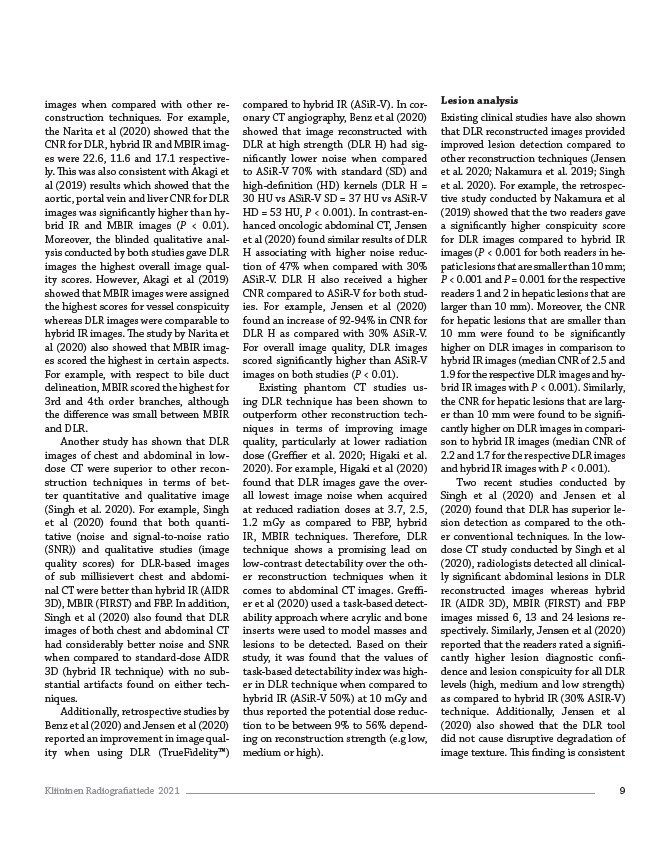
images when compared with other re-construction
techniques. For example,
the Narita et al (2020) showed that the
CNR for DLR, hybrid IR and MBIR imag-es
were 22.6, 11.6 and 17.1 respective-ly.
This was also consistent with Akagi et
al (2019) results which showed that the
aortic, portal vein and liver CNR for DLR
images was significantly higher than hy-brid
IR and MBIR images (P < 0.01).
Moreover, the blinded qualitative anal-ysis
conducted by both studies gave DLR
images the highest overall image qual-ity
scores. However, Akagi et al (2019)
showed that MBIR images were assigned
the highest scores for vessel conspicuity
whereas DLR images were comparable to
hybrid IR images. The study by Narita et
al (2020) also showed that MBIR imag-es
scored the highest in certain aspects.
For example, with respect to bile duct
delineation, MBIR scored the highest for
3rd and 4th order branches, although
the difference was small between MBIR
and DLR.
Another study has shown that DLR
images of chest and abdominal in low-dose
CT were superior to other recon-struction
techniques in terms of bet-ter
quantitative and qualitative image
(Singh et al. 2020). For example, Singh
et al (2020) found that both quanti-tative
(noise and signal-to-noise ratio
(SNR)) and qualitative studies (image
quality scores) for DLR-based images
of sub millisievert chest and abdomi-nal
CT were better than hybrid IR (AIDR
3D), MBIR (FIRST) and FBP. In addition,
Singh et al (2020) also found that DLR
images of both chest and abdominal CT
had considerably better noise and SNR
when compared to standard-dose AIDR
3D (hybrid IR technique) with no sub-stantial
artifacts found on either tech-niques.
Additionally, retrospective studies by
Benz et al (2020) and Jensen et al (2020)
reported an improvement in image qual-ity
when using DLR (TrueFidelity™)
compared to hybrid IR (ASiR-V). In cor-onary
CT angiography, Benz et al (2020)
showed that image reconstructed with
DLR at high strength (DLR H) had sig-nificantly
lower noise when compared
to ASiR-V 70% with standard (SD) and
high-definition (HD) kernels (DLR H =
30 HU vs ASiR-V SD = 37 HU vs ASiR-V
HD = 53 HU, P < 0.001). In contrast-en-hanced
oncologic abdominal CT, Jensen
et al (2020) found similar results of DLR
H associating with higher noise reduc-tion
of 47% when compared with 30%
ASiR-V. DLR H also received a higher
CNR compared to ASiR-V for both stud-ies.
For example, Jensen et al (2020)
found an increase of 92-94% in CNR for
DLR H as compared with 30% ASiR-V.
For overall image quality, DLR images
scored significantly higher than ASiR-V
images on both studies (P < 0.01).
Existing phantom CT studies us-ing
DLR technique has been shown to
outperform other reconstruction tech-niques
in terms of improving image
quality, particularly at lower radiation
dose (Greffier et al. 2020; Higaki et al.
2020). For example, Higaki et al (2020)
found that DLR images gave the over-all
lowest image noise when acquired
at reduced radiation doses at 3.7, 2.5,
1.2 mGy as compared to FBP, hybrid
IR, MBIR techniques. Therefore, DLR
technique shows a promising lead on
low-contrast detectability over the oth-er
reconstruction techniques when it
comes to abdominal CT images. Greffi-er
et al (2020) used a task-based detect-ability
approach where acrylic and bone
inserts were used to model masses and
lesions to be detected. Based on their
study, it was found that the values of
task-based detectability index was high-er
in DLR technique when compared to
hybrid IR (ASiR-V 50%) at 10 mGy and
thus reported the potential dose reduc-tion
to be between 9% to 56% depend-ing
on reconstruction strength (e.g low,
medium or high).
Lesion analysis
Existing clinical studies have also shown
that DLR reconstructed images provided
improved lesion detection compared to
other reconstruction techniques (Jensen
et al. 2020; Nakamura et al. 2019; Singh
et al. 2020). For example, the retrospec-tive
study conducted by Nakamura et al
(2019) showed that the two readers gave
a significantly higher conspicuity score
for DLR images compared to hybrid IR
images (P < 0.001 for both readers in he-patic
lesions that are smaller than 10 mm;
P < 0.001 and P = 0.001 for the respective
readers 1 and 2 in hepatic lesions that are
larger than 10 mm). Moreover, the CNR
for hepatic lesions that are smaller than
10 mm were found to be significantly
higher on DLR images in comparison to
hybrid IR images (median CNR of 2.5 and
1.9 for the respective DLR images and hy-brid
IR images with P < 0.001). Similarly,
the CNR for hepatic lesions that are larg-er
than 10 mm were found to be signifi-cantly
higher on DLR images in compari-son
to hybrid IR images (median CNR of
2.2 and 1.7 for the respective DLR images
and hybrid IR images with P < 0.001).
Two recent studies conducted by
Singh et al (2020) and Jensen et al
(2020) found that DLR has superior le-sion
detection as compared to the oth-er
conventional techniques. In the low-dose
CT study conducted by Singh et al
(2020), radiologists detected all clinical-ly
significant abdominal lesions in DLR
reconstructed images whereas hybrid
IR (AIDR 3D), MBIR (FIRST) and FBP
images missed 6, 13 and 24 lesions re-spectively.
Similarly, Jensen et al (2020)
reported that the readers rated a signifi-cantly
higher lesion diagnostic confi-dence
and lesion conspicuity for all DLR
levels (high, medium and low strength)
as compared to hybrid IR (30% ASIR-V)
technique. Additionally, Jensen et al
(2020) also showed that the DLR tool
did not cause disruptive degradation of
image texture. This finding is consistent
Kliininen Radiografiatiede 2021 9